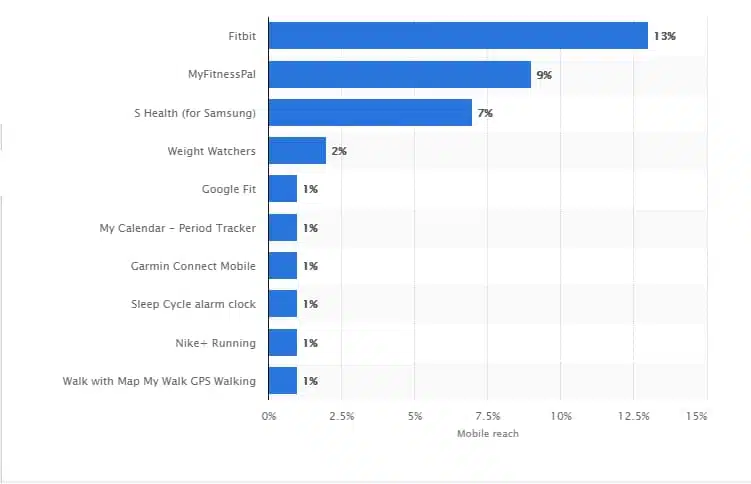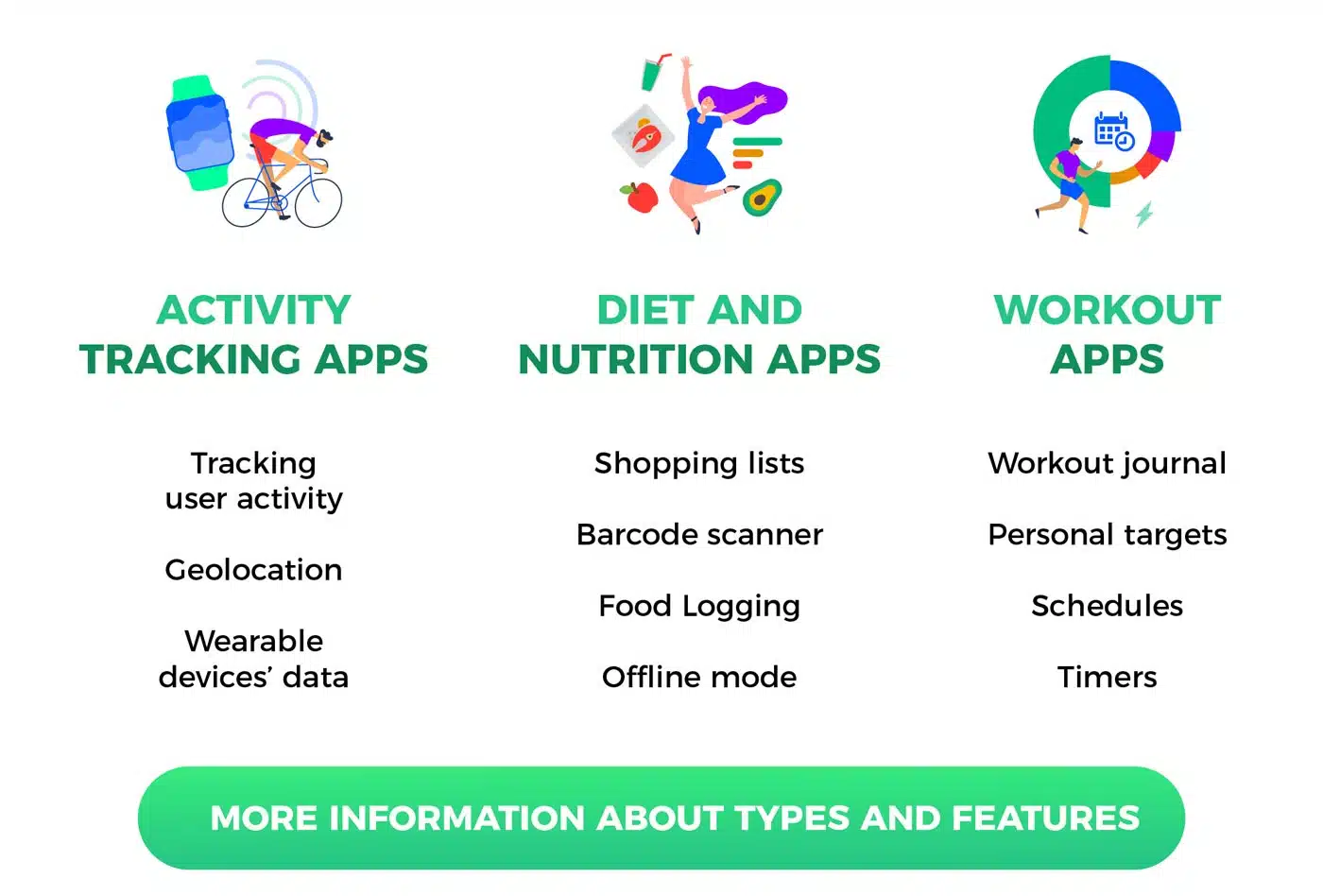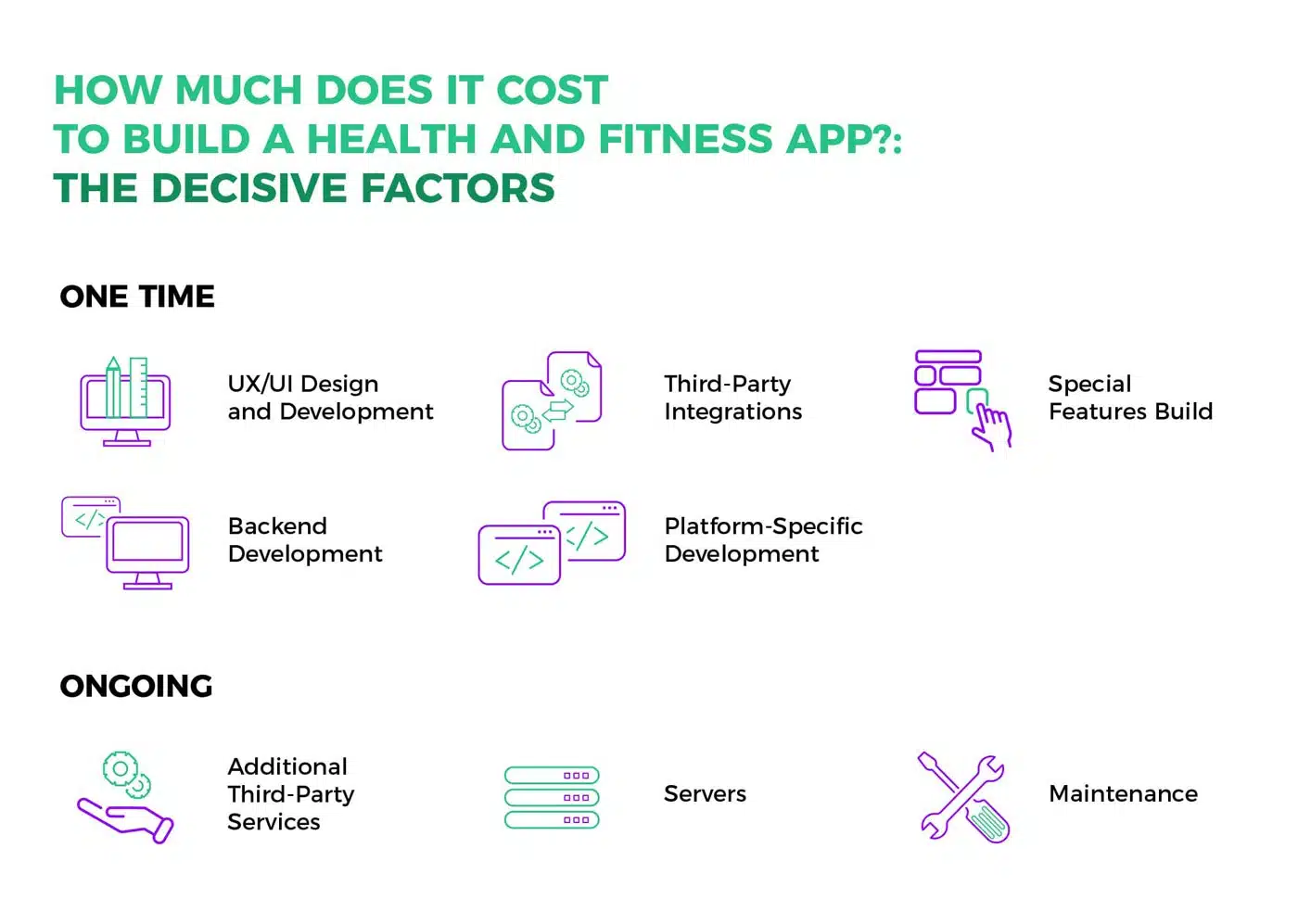Table of Contents
Did you know that the fitness app market currently exceeds 2 billion dollars and is expected to grow up to over 14 billion dollars by 2026?
If you landed on this article, you probably already have an idea of what the fitness app market looks like and, most likely, already know what type of solution would help others live healthier lifestyles. By now, it’s not so much a matter of whether to create a fitness app or not but rather about how to go about doing so. If you’re thinking “how do I create my own fitness app?” this is the right place for you.
When it comes to fitness app development, planning will be the single most important aspect – it will make or break your big new project. So, take your time figuring out what will really drive adoption in the market. Developing an “easy-fix” version of whatever problem-solving solution you’re thinking about will not stand a chance against the fierce competition you’ll encounter once the app is up and running. Just take a look at the most popular health and fitness apps in the US as of May 2018:

“This statistic gives information on active reach of the most popular health and fitness apps in the United States, sorted by mobile reach. As of May 2018, Fitbit was ranked first with 13 percent mobile penetration. MyFitnessPal was ranked third with a 9 percent reach”. Source.
Competing against top dogs in this business will take a mix of the right development methodology, specific UX/UI, product marketing and thorough promotion. The great news is that if you are able to condense your problem-solving idea into the optimal solution for your market, you’re looking at great long-term results.
So, how to go about it? There are 3 main considerations when it comes to creating a fitness app. In fact, the following will probably apply for any type of app but we will focus on how these phases of the project relates directly to health and fitness app development:
- Specifications and budget,
- The monetization strategy,
- Promotion and product adoption,
It’s not uncommon to think that “building” an application ends at the web development stage – but that couldn’t be further from the truth. Creating a fitness application will do nobody any good if it’s not easy to find or even easy to use. With that said, let’s dive deep into the entire process of building a health and fitness app.
How to Make a Fitness App
First things first, we’re talking about mobile development. Sure, there are some types of fitness apps that require desktop versions. For example, if you’re building an application for gyms to manage schedules or payments but, in general, the fitness industry needs mobility at its finest. In fact, if you’re thinking about something like an activity tracker, you should consider a wearable version of your application.
Just to be clear, let’s briefly talk about what is a fitness app. A health and fitness app is one that is built to help a user carry out a healthy lifestyle, one way or another. That means that this category encompasses everything from weight loss workouts to meal planning.
Now that that’s settled, you can start drilling down on your audience’s needs, the specifications for your project, the process that it will entail and budget considerations on how to make a fitness app.
Research
You might be tempted to bypass this part of the process because you have your own original idea – that’s fine. It’s important to understand, however, that your idea or some variation of it might already exist. Market, competition and user research are a must before getting started. Through this research you’ll be able to further understand what is the “hole” in the market and decide on the features and functionalities that match those needs.
Who uses fitness apps anyway? The users will depend on the type of app you’re creating, of course, but usually apps are used by one of three demographics: users searching for health and fitness guidance, personal trainers and gyms or studios. User research will allow you to pinpoint the right audience for your app, thus helping you gear the entire application and marketing strategy to cater to them.
Defining Your Specs
Being able to properly relay back to the development team exactly what you want will save you a lot of headaches and avoid unmatched expectations. To create a fitness app, properly defining your project’s specifications will be divided in two very important aspects: the features and functionality.
The Features
The features your fitness app will have will pretty much be the driving force of the entire project. Although it might seem obvious, you might want to identify what type of fitness app you want to create and what are the core features it will have. This will be the foundation of your product specs.
The types of health and fitness apps can pretty much be divided into 3 main categories: activity tracking, diet and nutrition, and workout apps. Although each of these types have their unique set of requirements, there are a few recommended core features that should be present in all three:
- Personalized user accounts,
- Social integration,
- Push notifications and reminders,
Additional to the features above, you will need to consider the specific ones that will allow you to carry out the proposed goal of your application. Here are some common features used inn each type of health and fitness app:
Functional Specifications
The functional specifications will cover a standard list of items the app should perform and how it should do so. The functional specs should look like a thorough, descriptive list of your applications’ interaction mechanism, the user experience and user interface desired, as well as usability parameters such as the sections of the app, menus, and screens. You’ll also need to think about compatibility with other systems like a CMS, e-commerce or others.
Budget
How much does it cost to make a fitness app? Matter of fact is, it’s not a one-size-fits-all kind of deal when it comes to health and fitness app budgeting as the cost will depend on its type and complexity. Our intention here, more than giving you a specific dollar amount, is to share the 3 main factors that will drive your costs both from the get go and in the long run.
Development-Related Costs
The first cost you’ll have to consider is the one associated to actually bringing your application to life. The application’s look and feel will be a driving force when it comes to development hours. UI and UX are probably the most important selling points of a commercial app so you’ll want to make sure yours has a good flow, actions are intuitive and it is visually attractive.
“When it comes to development hours for a health and fitness app, it will depend on your prototype, features and functionality.”
Cost-Saving Tips
- Some “special features” increase development hours so you can also opt to use third-party companies that facilitate the implementation of features like the ability to process payments or enabling real-time communication. These types of third-party services will influence development time by requiring you to just integrate the service as opposed to developing the feature yourself.
- Integrate cross platform mobile app development services from the beginning. You no longer need multiple different developers for each platform so you can use cross-platform frameworks such as Reactive Native, Ionic, or Xamarin to be able to shed some costs on having to build different versions separately.
- Use Backend as a Service (BaaS) providers such as Google Firebase to be able to limit the entire backend development. These types of services will keep your app highly administrable and can significantly cut the time of execution.
Monthly Infrastructure Costs
Another driving force for costs are ongoing fees. You’ll want to pay attention to these even (or especially) while your app is being built because recurrent costs, over time, tend to be more costly than the actual development.
Servers are one of the factors. We need to say that servers can actually run as little as $5.00 USD per month with services like AWS Lightsail but this will depend on the number of users your app is running for. Since the goal is to have more and more users, over time, this fee will increase and eventually add up.
The second factor is the third-party vendors we discussed above. Of course, it will save some money initially, however, you must take into account that these third parties are based on either a monthly cost or a per-use fee. So the charge could be every time someone makes a call, or every time you make a transaction – again, it’s great to be able to get started but, if all goes well, over time it will become a considerable monthly fee. Additionally, BaaS providers can run anywhere between $0 and a couple thousand dollars per month.
Maintenance
Maintenance is not a matter of if, but rather when. Truth of the matter is that, if you want your app to keep running over time, you’ll need to do some maintenance work – usually every year or so. The reason for this is that, to keep your app running, it will have to accommodate to the endless new versions of devices, operating systems, screens and more.
Usually, apart from regular upkeep, you’ll also want to add new features or functionality to be able to stay afloat with user demands. This is actually not considered maintenance, but rather, development itself – and so the process goes full circle and starts again at the first factor.
Take your fitness idea from zero to hero with professionals in the field, request a free quote with one of our experts.
Monetizing Your Fitness App
Alright, you’ve done the work and now know how to make a fitness app. You’ve gone out there and figured out what the hole in the market is and you’ve filled it with a fresh, new application – chances are you’ve spent a good chunk of change on it too. Even if you’re trying to make a difference, let’s be real, you want to make some kind of profit from this investment. So, let’s talk about the most common monetization models and how they apply to your new fitness app.
In-app Advertising
The oldie but goodie ad. Yes, it can be annoying to see ads on our apps but they are, probably, the most common monetization model. If your app’s raison d’être calls for ads, don’t miss out on the chance to make some real profit.
The entire premise of this model is to make the app free for users, bring in traffic and generate revenue by adding ads. About setting up ads, you can go about it two ways, either set up agreements with the end buyers directly or use an ad network – the first option, of course, a lot more profitable than the last but also more difficult to implement.
Now, ad networks are a world on their own. CPMs, customization, and intrusiveness among other factors need to be considered when choosing a tool. Here are a few of the most popular ad networks to choose from:
- Media.net
- Admob
- StartApp
- Flurry
- Inmobi
- Millennial Media
Health and fitness apps directly related to fitness tracking tend to use this type of monetization strategy the most and are very popularly used by companies that sell activity tracking devices.
Paid Subscriptions
Another very common way to extract some revenue from your fitness app is to have a paid subscription. Now, paying for an application without being able to gauge the benefits it brings can be tricky for users. That’s why, if you choose this route, you’ll want to make sure there is some type of free trial available. Making it possible for users to try out your app for 15 to 30 days will make it much easier for you to come back around at the end of the trial period and ask for their money.
When it comes to subscriptions, you also want to think about plans and pricing. Will there be a one-time fee or is it an ongoing type of deal? If your app caters to several different audiences, you can also make it paid for some and free for others. This is usually achieved through “freemiums”.
A freemium refers to a free version of an application. When it comes to fitness apps, a freemium model makes it easier to pull a lot of traffic and downloads – after the crowd is in, it’s a matter of making them stay and upselling.
Paid Features
Offering special features on a paid subscription is a great way to take already-engaged users to the next level. Allowing your audience to get access to an unlimited amount of workouts instead of a restricted set of exercises on the free version, for example, is commonly used in fitness apps. But it can literally be anything! From unlocking a specific feature to extra tracking capabilities or meal plans, health and fitness app users are willing to pay the price for a healthier lifestyle if you’re willing to provide the means for one.
Mix Your Monetization Strategy
You can actually implement a few of these models in a single successful app. Think about what makes the most sense for your users, audience and business or try out a few different approaches. You can have ads on the freemium version and only disable them if the user pays the premium subscription. It’s all a matter of bringing more value, delivering on that value and making it visible to your users.
Promoting Your Fitness App
It’s all said and done. Your application is fully functional and, hopefully, you’ve done some research and found out exactly what your users are willing to pay for. You might’ve even done some beta testing to make sure your application is what users are expecting and they don’t have any sort of trouble using it – great work! But now comes the real deal, will people download your app? Will they even find it?
Alright, so it’s time to get involved with marketing now. Getting your fitness app out there in the midst of thousands upon thousands of other related apps – tricky business. There are many topics to discuss when trying to get ahead from the crowd and make your app as visible as possible.
App Store Optimization (ASO)
Have you ever heard of SEO? Well, ASO is the app store version of that but less complex. ASO is becoming increasingly important due to the fierce competition apps face, especially on the two main stores: App Store and Google Play. As the goal of SEO is to drive more traffic into your website, the goal of ASO is to increase your number of downloads by making sure that your store listings are ‘algorithm-friendly’. Finding the right keywords for your app and audience, creating engaging copy and screenshots that fit the parameters of the stores and increasing your app reviews are just a few of the items you’ll have to work on to get ASO just right for your app. In any case, it’s important for you to seek professional help on this. The mere difference between using “fitness” and “workout” as a keyword can be game-changing.
The Media
Social networks, influencers and media outreach are a great way to get your application out there. Just imagine having your app featured in a “Best Fitness Apps” article that’s already very well positioned on the net. Or having an entire article written about your app and posted on a news outlet. It drives traffic and, in turn, drives downloads.
Find the best outlets and social networks for your audience, invest some time building your online presence and drive the visibility of your brand new product!
Landing Page
Talking about online presence. Not all apps need a website, you can certainly start out with a landing page (a single page of information). It’s a lot more time and resource effective to create a landing page and it can get you started with your online presence. It’s actually pretty common for applications to have a microsite – at least to start out with.
Both the App Store and Google Play Store only allow for a certain limit of characters on the description, how much can you really say there? Sure, the most important part about your app but can it all fit? A landing page is able to really show your benefits in detail and provide the online presence you will need to create validity for your product.
Advertising
Some marketing efforts like social media, hiring an SEO services company, and outreach are more long-term as they usually take a while to show any real results. Running targeted ads is a great short-term tactic that can give your brand-new app the boost it will need at the beginning.
When it comes to advertising, you might want to get started with App Store or Google Play ads for your fitness app. This is how you’ll be able to position your application higher up and even manage your conversions to ensure downloads. Another option that works well particularly for health and fitness app promotion are social media ads. Facebook and Instagram ads in particular work well because the industry is well positioned in these platforms.
There you have it: from creating the specs for your health and fitness app to ensuring downloads, the road to success is yours for the grabs. Don’t be scared to create “yet another fitness app”, the data supports a continuous growth in the market and, although you’ll have competition to mind, building and executing a thorough plan based on these suggestions will help you get there. Ready to create your own fitness app? Talk to us!









